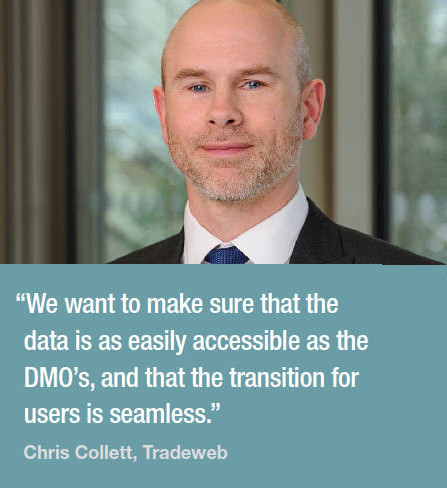The DESK talks to Chris Collett, Director, European Governments at Tradeweb, about the transformation of Gilt reference pricing in 2017.
The end-of-day Gilt and Treasury bill reference prices are a cornerstone of UK fixed income trading. In January 2015, the UK Debt Management Office (DMO) announced it would withdraw from the provision of these reference prices.
Tradeweb and FTSE Russell, working together, picked up the baton. In July 2016, a request for proposal (RFP) was published, and a review found that Tradeweb and FTSE Russell had put forward “the strongest proposal for future reference price provision”.
Since late March 2017 they have produced full sets of end-of-day reference prices for Gilts, strips and Treasury bills. The UK DMO plans to cease publishing prices in July 2017, at which point the market will fully transition to the new Tradeweb FTSE Gilt Closing Prices.
 What is the story behind Tradeweb’s decision to supply end-of-day Gilt pricing?
What is the story behind Tradeweb’s decision to supply end-of-day Gilt pricing?
Tradeweb has successfully been trading UK Gilts for the past 13 years, and in 2016 alone, we saw more than £600 billion traded in Gilt instruments. As part of our long-term commitment to the UK Gilt market, we introduced our end-of-day Gilt reference prices service in May 2015, which involved sending prices daily to more than 20 institutional clients, Gilt-edged market makers (GEMMs), the UK DMO, and other market participants. We already supported functionality that allows our clients to trade with a counterparty at the closing levels, so we were already embedded in the workflow.
Ultimately, this is core business for us. Taking over from the UK DMO to provide our end-of-day reference price is a natural ‘next step’ that builds on market acceptance and very solid foundations.
Following the UK DMO’s initial consultation, we responded to the RFP along with five other entities, and last October the reviewing body announced that our combined proposal, with FTSE Russell, proved to be the strongest in the RFP process.
How would you characterise the new pricing mechanism?
We needed to start off with a transparent price, as well as a transparent and robust methodology. The market relies on end-of-day prices, and they are also a focus for regulators, therefore, it’s a big commitment for us to succeed the UK DMO in providing these prices going forward. Once the transition is complete, you cannot fail to calculate them on any given day or delay their delivery. We will, actually, be providing them at 4.45pm, which is 15 minutes earlier than the DMO does right now.
What is the timeline and how will the transition period work?
The transition period is currently underway. We committed to the UK DMO that we would calculate prices and allow clients to start testing them in advance. To achieve this goal we had to make a number of adjustments to our production environment, and that required quite a few technology changes for us.
We have now been calculating prices since March, so clients and market makers have been able to view them before the go-live date in July.
How does the new methodology work?
GEMMs are streaming two-way executable prices to our platform throughout the day for these instruments. We capture those prices over a two-minute window from 4.14pm to 4.16pm, and break it down into 24 five-second intervals for each security. We then run our calculation methodology 24 times, before averaging the final prices to create a mid-price per instrument.
The prices are additionally subject to two layers of filtering. First, we eliminate outlying GEMMs by standard deviation, and then we remove randomly-chosen GEMMs. Furthermore, our market data team perform a verification process to check the prices for quality. So, it’s an in-depth process that is carried out each day, before the prices are released into the market at 4.45 pm.
What guided the development?
When we started to discuss potential processes for alternative pricing mechanisms with the market, the importance of adhering to the IOSCO principles around end-of-day prices quickly became apparent. IOSCO places great importance on aspects such as robust methodology, the hierarchy of pricing, governance, oversight and accountability. So that’s been the building block throughout the whole methodology development process.
Was the collaboration with FTSE part of that?
When it came to finalising the process, we decided to engage with existing administrators, particularly with regard to adhering to the IOSCO principles. FTSE was the natural choice, given their administration experience and their strength in the Gilt indices market.
How does the collaboration work?
We are the calculation entity, capturing the prices before distributing them to the entire market. FTSE acts as the administrator, consistent with the IOSCO principles, and manages the oversight committee. Appointment to the committee is by invitation and extended on a personal level to individual market practitioners, who meet every quarter to discuss data and results, or any issues arising.
As a consumer of the UK DMO end-of-day data, what do I need to know?
There are more than 100 entities that consume the UK DMO’s data right now. We want to make sure that the data is as easily accessible as the DMO’s, and that the transition for users is seamless. We have hence put in place two distribution methods to suit the needs of different user types.
Firstly, authorised firms receive at 4.45pm a Marks file, an end-of-day file that consumers of the data on the day can get access to, once they have signed a market data agreement with Tradeweb. Secondly, individual or non-professional investors can access Gilt data at 12 o’clock the next day, simply by registering with our InSite portal.
In addition, we have been in negotiations and discussions with existing data distributors, who will continue to deliver the prices to clients and the GEMMs, as well as other users. The next step is for the DMO to select and communicate a date for when they stop publishing end-of-day prices in July. In the meantime, we continue to work closely with FTSE to inform and communicate with the public on how the transition will impact them and their workflow.
©TheDESK 2017[divider_to_top]
[divider_line]
©Markets Media Europe 2025












